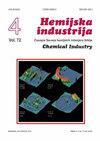Transport of silver nanoparticles from nanocomposite Ag/alginate hydrogels under conditions mimicking tissue implantation
IF 0.8
4区 工程技术
Q4 ENGINEERING, CHEMICAL
引用次数: 3
Abstract
The aim of this work was to assess phenomena occurring during AgNP transport from nanocomposite Ag/alginate hydrogels under conditions relevant for potential biomedical applications as antimicrobial soft tissue implants. First, we have studied AgNP migration from the nanocomposite to the adjacent alginate hydrogel mimicking soft tissue next to the implant. AgNP deposition was carried out by the initial burst release lasting for ~24 h yielding large aggregates on hydrogel surfaces and smaller clusters (~400 nm in size) inside. However, the overall released content was low (0.67%) indicating high nanocomposite stability. In the next experimental series, release of AgNPs, 10–30 nm in size, from Ag/alginate microbeads in water was investigated under static conditions as well as under continuous perfusion mimicking vascularized tissues. Mathematical modeling has revealed AgNP release by diffusion under static conditions with the diffusion coefficient within the Ag/alginate hydrogel of 6.9´10 –19 m 2 s –1 . Conversely, continuous perfusion induced increased AgNP release by convection with the interstitial fluid velocity estimated as 4.6 nm s –1 . Overall, the obtained results indicated the influence of hydrodynamic conditions at the implantation site on silver release and potential implant functionality, which should be investigated at the experimentation beginning using appropriate in vitro systems.模拟组织植入条件下银/海藻酸盐纳米复合水凝胶中银纳米颗粒的运输
这项工作的目的是评估在与抗菌软组织植入物的潜在生物医学应用相关的条件下,纳米复合Ag/藻酸盐水凝胶在AgNP转运过程中发生的现象。首先,我们研究了AgNP从纳米复合材料迁移到植入物旁边的模拟软组织的相邻藻酸盐水凝胶。AgNP沉积是通过持续约24小时的初始爆裂释放进行的,在水凝胶表面产生大的聚集体,在水凝胶内部产生较小的团簇(约400nm大小)。然而,总释放含量较低(0.67%),表明纳米复合物的稳定性较高。在下一个实验系列中,研究了在静态条件下以及在模拟血管化组织的连续灌注下,从水中的Ag/藻酸盐微珠中释放大小为10-30 nm的AgNPs。数学模型显示,AgNP在静态条件下通过扩散释放,Ag/藻酸盐水凝胶内的扩散系数为6.9´10–19 m 2 s–1。相反,持续灌注通过对流诱导AgNP释放增加,间质液速度估计为4.6 nm s–1。总的来说,所获得的结果表明了植入部位的流体动力学条件对银释放和潜在植入物功能的影响,这应该在实验开始时使用合适的体外系统进行研究。
本文章由计算机程序翻译,如有差异,请以英文原文为准。
求助全文
约1分钟内获得全文
求助全文
来源期刊

Hemijska Industrija
工程技术-工程:化工
CiteScore
1.60
自引率
11.10%
发文量
12
审稿时长
6-12 weeks
期刊介绍:
The Journal Hemijska industrija (abbreviation Hem. Ind.) is publishing papers in the field of Chemical Engineering (Transport phenomena; Process Modeling, Simulation and Optimization; Thermodynamics; Separation Processes; Reactor Engineering; Electrochemical Engineering; Petrochemical Engineering), Biochemical Engineering (Bioreactors; Protein Engineering; Kinetics of Bioprocesses), Engineering of Materials (Polymers; Metal materials; Non-metal materials; Biomaterials), Environmental Engineeringand Applied Chemistry. The journal is published bimonthly by the Association of Chemical Engineers of Serbia (a member of EFCE - European Federation of Chemical Engineering). In addition to professional articles of importance to industry, scientific research papers are published, not only from our country but from all over the world. It also contains topics such as business news, science and technology news, information on new apparatus and equipment, and articles on environmental protection.
 求助内容:
求助内容: 应助结果提醒方式:
应助结果提醒方式:


